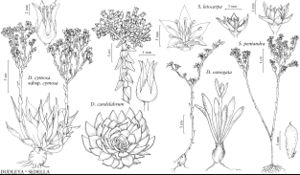Sedella pentandra
Madroño 3: 240, plate 12, figs. 4, 5. 1936,.
IllustratedEndemic
Synonyms: Parvisedum pentandrum (H. Sharsmith) R. T. Clausen
Revision as of 23:43, 5 November 2020 by imported>Volume Importer
Plants 0.3–1.3 dm, often with 1–4 ascending branches shorter than main axis; hypocotyl 1–2 cm. Stems 5–15-noded. Leaf blades 0.4–0.7 × 0.2–0.3 cm. Cymes 1–5-branched, 2–12-flowered, sometimes flowers solitary, 1–4 cm. Flowers 2–3 mm diam.; calyx base thickened for 1 mm; petals ascending, later appressed to utricles, pale greenish yellow or with dorsal red streak, ovate-lanceolate, 1.5–2 × 0.5–0.6 mm, apex acute; stamens 5; pistils 1 mm, adaxially stipitate-glandular; styles erect, 0.2–0.4 mm. Utricles erect and appressed, 1.2–1.5 mm. Seeds 0.7–0.9 mm. 2n = 18.
Phenology: Flowering spring.
Habitat: Thin soil on slate, shale, sandstone, or serpentine
Elevation: 300-700 m
Discussion
M. W. Skinner and B. M. Pavlik (1994) considered Sedella pentandra for listing as rare in California but rejected it as too common.
Selected References
None.
Lower Taxa
None.

